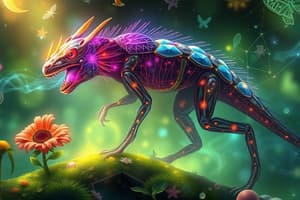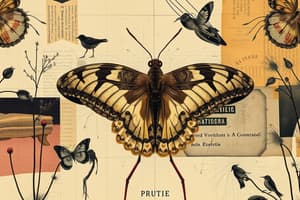Podcast
Questions and Answers
What happens when humans ingest the embryonated eggs?
What happens when humans ingest the embryonated eggs?
- They are broken down into nutrients for the body.
- They are immediately excreted from the body.
- They are stored in the stomach for later use.
- They start to hatch in the human small intestine and multiply. (correct)
What is unique about the body structure of annelids?
What is unique about the body structure of annelids?
- They are always hermaphrodites.
- They have a hard shell that protects them.
- They have true segmentation of their bodies. (correct)
- They have no internal organs.
What is the characteristic of flatworms that replaces their circulatory system?
What is the characteristic of flatworms that replaces their circulatory system?
- A highly developed nervous system.
- A unique respiratory system.
- A complex digestive system.
- A system of diffusion for oxygen and nutrients. (correct)
What is the phylum Mollusca characterized by?
What is the phylum Mollusca characterized by?
Which phylum is the second-largest animal phylum?
Which phylum is the second-largest animal phylum?
What is the function of the intestinal microflora in humans who have ingested embryonated eggs?
What is the function of the intestinal microflora in humans who have ingested embryonated eggs?
What is the term for having both male and female reproductive organs?
What is the term for having both male and female reproductive organs?
What is the meaning of the Latin word 'annelus'?
What is the meaning of the Latin word 'annelus'?
What is the characteristic of Platyhelminthes that allows them to obtain oxygen and nutrients?
What is the characteristic of Platyhelminthes that allows them to obtain oxygen and nutrients?
What is the term for the hard outer covering of some mollusks?
What is the term for the hard outer covering of some mollusks?
Flashcards are hidden until you start studying




